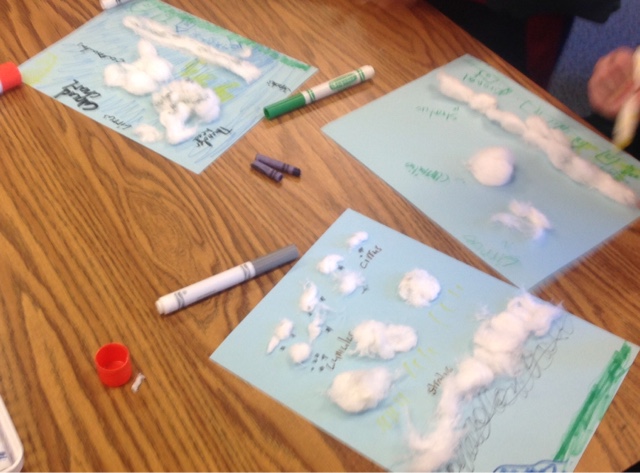Play practice is going very well. We are having fun using drama skills, singing and getting together as a team.
Friday, April 15, 2016
Shadow Experiment
Do shadows change outside during the day? Why do they change? Why is the sun in different positions in the sky at different times of the day? We asked these questions and then did an experiment to find out the answers. We measured the length of the shadow of a 100cm (1 meter) stick at about 8:45 a.m. and then again at about 12:30 p.m. We also noticed where the sun was in the sky at both times. We found out that most of the shadows were over 200 cm in the morning and less than 80 cm in the early afternoon. We discussed why we found these differences and how this experiment helps prove that the earth is moving. These are big concepts that take a while to sink in! Hopefully, these experiences help us notice the natural world around us.
Get Air
Thank you Hands On Nature volunteers! We explored air with our team of parents this month. We learned about the different types of clouds. Then we made cloud charts and weather vanes. "I can put my cloud chart next to my window so I can tell what clouds are in the sky," decided one of the children.
Monday, April 11, 2016
Electronic Books
Mrs. Ahern, our librarian, has taught us how to navigate our way to electronic books on the school's library webpage. These books are also known as "E Books." Our school community has access to many titles that are interactive. Children can read the books themselves, have the computer read words to them that they don't know, and have the whole book read to them. Readers can search for books by interest, level and genre. What a great resource for summer reading! In a separate email, I will give instructions for how to access these books. (The children have practiced how to access the books several times, and should be able to get to them on their own.)
Peer Conferences
We are meeting with peers to conference about our narrative stories. What is peer conferencing? Here are our ideas. This is what is looks like: partners sitting close, looking at each other, focusing attention on the writing. This is what is sounds like: giving compliments, asking questions, making suggestions.
Words Come Alive
We are working with Flynn Arts educator, Joan Robinson, thanks to grant money from the PTO and the VT Arts Council. We are learning about elements of acting: volume, facial expression, emotional tone and gestures. We are using these elements to act out stories. First we acted out stories from a book series called Elephant and Piggie. Next we will use these acting skills to act out stories that we have written. Through acting we are finding out how to add more description to our writing. We are also using these elements to practice reading fluently. And, finally, we are having fun trying out these acting moves in our rehearsals for our team play, Life Cycles.
Fractions
We are beginning to understand the concept of fractions. We have made our own fraction kits and have investigated equal fractions, such as two-fourths equaling one-half. We have looked at fractions of wholes (often used example: pie) and fractions of sets (a group of items: half of the class wore sneakers).
Metric Measuring
We made "army ant" centimeter rulers and learned about the adaptations of these 1 cm ants. (These rulers are in contrast to our "inch worm" rulers.) We estimated lengths in centimeters and then measured with our metric rulers. Many children made connections to the metric system from driving in Canada to seeing liters of soda in stores. We researched the metric system and found out that 2 other countries in the world in addition to the USA do not use the metric system: Myanmar and Liberia.
Our final project was to estimate and find out how long 14 meters is. That is the length of a colony of army ants on the move to a new eating area. We found out that in some parts of the world families leave their doors open for the army ants because once the ants pass through, all of the other pesky bugs in the house will have been eaten!
Our final project was to estimate and find out how long 14 meters is. That is the length of a colony of army ants on the move to a new eating area. We found out that in some parts of the world families leave their doors open for the army ants because once the ants pass through, all of the other pesky bugs in the house will have been eaten!
Subscribe to:
Comments (Atom)







































